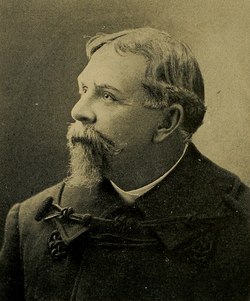| Emerson H. Liscum | |
|---|---|
 | |
| Born | July 16, 1841 |
| Died | July 13, 1900 (aged 58) |
| Place of birth | Huntington, Vermont, U.S. |
| Place of death | Tianjin, China |
| Buried at | Arlington National Cemetery |
| Allegiance | United States |
| Service/branch |
Union Army United States Army |
| Years of service | 1861–1900 |
| Rank |
|
| Commands held |
24th Infantry Regiment 9th Infantry Regiment |
| Battles/wars |
|
| Relations | Alexander S. Diven (father-in-law) |
Emerson Hamilton Liscum (July 16, 1841 – July 13, 1900) was a U.S. Army officer who was killed in battle at Tientsin, China during the Boxer Rebellion.
He joined the U.S. Army in 1861 to fight in the American Civil War. After the war he remained in the Army and rose to the rank of Colonel. While assigned to the 9th U.S. Infantry, he led his men during the Boxer Rebellion. Colonel Emerson died at the Battle of Tientsin, China on July 13, 1900. He was one of the 150 American soldiers who were killed by Chinese sharpshooters defending the city; a bullet hit him in the stomach.[1]
"It was on 13 July 1900, during the assault on Tientsin, China, in the face of murderous fire that the wounded Regimental Commander, Colonel Emerson H. Liscum seized the National Colors himself from his fallen Color Sergeant. Colonel Liscum stood fearlessly, directing the attack on the city walls until he too was mortally wounded. His last words to his men were "Keep Up The Fire!" The assault continued with renewed vigor. As a result of this action, the Regiment earned its foremost trophy, the Liscum Bowl. The Colonel's last words, "Keep Up The Fire!" have become the Regimental Motto."[2]
Possibly the most important piece of 20th century silver metalwork, The Liscum Bowl, was created in 1901 to honor the Colonel and his regiment.
Fort Liscum in Valdez, in the Territory of Alaska, was named in his honor.
References[]
- ↑ Robert B. Edgerton (1997). Warriors of the rising sun: a history of the Japanese military. W. W. Norton & Company. p. 80. ISBN 0-393-04085-2. http://books.google.com/books?id=wkHyjjbv-yEC&pg=PA70&dq=sugiyama+akira&hl=en&ei=h_3_TLrBCIP88Aar4rnzBw&sa=X&oi=book_result&ct=result&resnum=5&ved=0CDUQ6AEwBDgK#v=onepage&q=allies%20devastating%20fire%20americans%20150%20men&f=false. Retrieved 2010-11-28.
- ↑ http://www.manchulight.com/motto.html
External links[]
The original article can be found at Emerson H. Liscum and the edit history here.